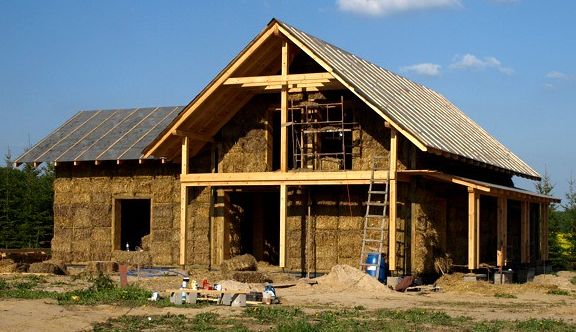We reached out to over 40 local builders and architects in Swindon to ask them about low carbon homes and natural building. Here is what we found.
- We know from the science, that we need to reduce our carbon footprint to slow down soaring temperatures.
- Our existing building & construction habits account for a large portion of energy consumption and emissions.
- Modern natural building techniques such as strawbale offer an easy low carbon alternative as well as providing healthy insulated homes with reduced emissions.
You’d think, based on the three statements above, that strawbale building should be coming on tap with widespread support & investment from the building industry, local authorities and the government.
The Grim Reality on the Ground
Aware that strawbale buildings are an ideal solution to our climate conundrum, we wanted to check out some local strawbale builds to take photographs, talk with residents and collect some data.
We didn’t find any, an online search for strawbale Swindon generates no relevant results.
So we contacted approx 50 local builders and architects in Swindon and asked them,
- do you have any experience with low carbon builds or natural building like strawbale?
- do you know of any local builds or builders providing such a service?
- would you be interested in trying a straw bale build?
We also contacted the local council and campaign groups who might know something.
Seems like there aren’t any strawbale buildings in Swindon, at least none of the people we contacted knew of any and there was a distinct lack of interest all round, the larger building firms didn’t even bother to respond.
Details of Our Communication with Local Builders & Architects
Swindon Builders
We contacted 33 local Swindon builders via email and had no response, so we then called them. None of our builders we spoke to had had experience with strawbale, neither did they know any local builds. There were only three, but we were pleased that at least three, expressed interest in being involved with a strawbale build.
Swindon Architects
We contacted 17 architects from the area around Swindon, this time a better response, three of them responded to our email, though again, they didn’t know of any local builds, but were interested in our article and would be open in being involved.
Green Builders & Architects within Range
As the response had been so poor, I found a list of 28 architects & builders from the region (as far as Bath, Oxford, Newbury etc.) at The Green Register, construction professionals skilled in sustainable building practices. This time we had a better results, responses from five firms, again, no knowledge of actual strawbale builds in Swindon, but some of these firms had experience with strawbale and were interested doing further projects.
Examples of Strawbale Buildings in the UK
Strawbale building isn’t new, there are excellent examples of strawbale builds available in places not far from Swindon, like in Devizes, Bath, Oxfordshire, Gloucestershire, Somerset etc.
Brambledale near Devizes, Wiltshire
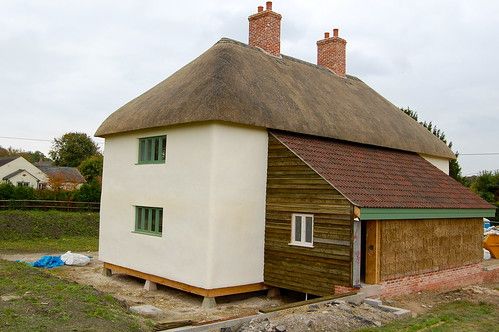
A strawbale home designed by DRA Architects in Devizes and documented by Secret Agent Marketing. The entire structure has been floated on staddle stones, which keep the bales dry and minimise the environmental impact of digging foundations. 1,200 straw bales were used by builders Treadstone Carpentry Solutions Ltd.
The two-storey house was built around a timber frame made from sustainable wood.
Straw Bale House in Cholsey, Oxfordshire
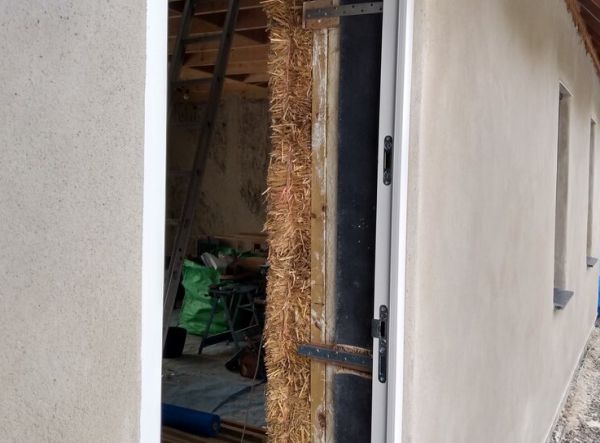
An eco house designed by The Breathable House Company, built almost entirely of straw and timber and rendered with a non-hydraulic lime putty. The render was then decorated in silicate paint. Traditional methods and materials applied to a contemporary, sustainable build.
Garden Studio in Stroud, Gloucestershire
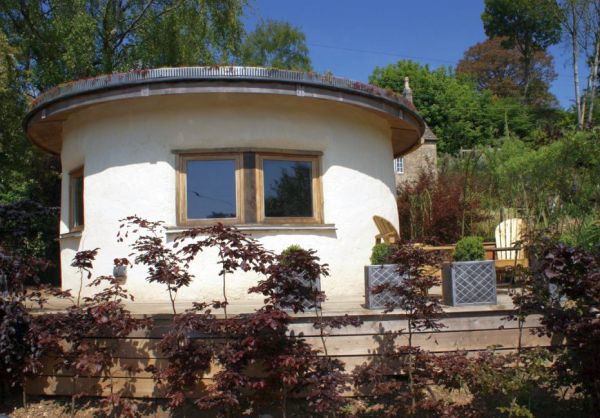
A single storey circular garden studio, cost £70,000, designed by Straw Works, self built with contractor help and training courses from SNaB. The resulting building is a multipurpose space with a small kitchen and toilet. Finished with an external lime render and a curved living roof, the building sits low, connecting it with the surrounding landscape.
Balehaus at Bath University Campus
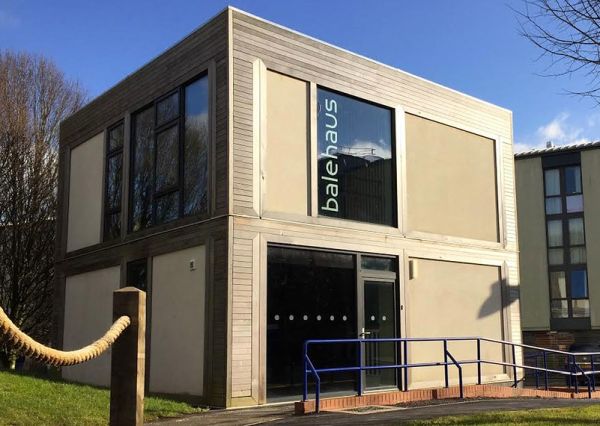
BaleHaus is an innovative two-storey straw building, constructed on campus at Bath University using ModCell pre-fabricated panels consisting of a wooden structural frame infilled with straw bales or hemp and rendered with a breathable lime-based system. The system delivers a sustainable method of construction, combining the lowest carbon footprint and the best operational CO2 performance of any system of construction currently available.
Strawbale House in Wedmore, Somerset
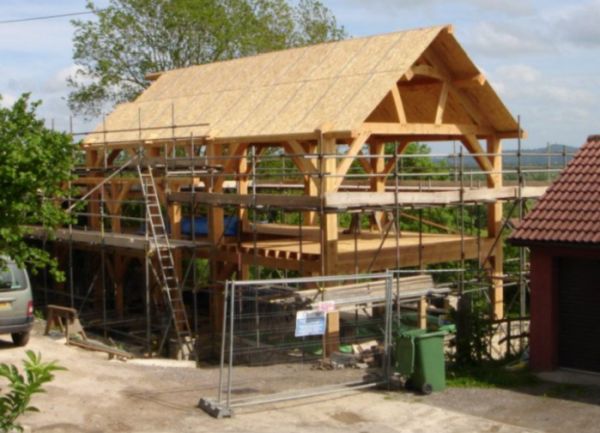
A two-storey timber-framed straw bale house designed together with O2i Design. The building’s green features include a timber frame and straw bale walls rendered with lime, passive solar heating and roof-mounted solar as well as rainwater harvesting and composting toilets.
A Timber Frame, Straw Bale Self Build for £67k
An off grid straw bale home in Exmoor National Park
A good list of straw bale builds in the UK is available from the ESBA European Strawbale Building Association.
The Benefits of Strawbale Building
A typical strawbale house construction process can look like this: a lighter than standard foundation, a wood frame for the structure, roof and covering (to protect the next stages of the build), strawbale infill between the wooden frame and finally a clay or lime render. However, this process can be easier when using pre fabricated wood & straw panels such as those offered by Agile Homes.
- quick, straightforward construction process, using pre fabricated panels the walls can be put up in a few days
- straw is an agricultural by product, it’s cheap, available locally and since it’s made up of carbon, using it is carbon capture
- straw provides excellent insulation for an energy efficient building
- straw allows the walls to breathe, allowing moisture to pass through and reducing mold or moisture-related issues
- fire resistance, clay rendered and properly compacted straw bales are relatively fire-resistant
Disadvantages of High Carbon Conventional Construction Techniques
Local builders in Swindon all use energy-intensive materials such as concrete, steel, and bricks, which contribute significantly to carbon emissions during their production. On top of that, they use toxic adhesives, inslutaion materials, paints and finishes and lot’s of plastic; industrial scale use of these products is not without consequences for our health.
Conventional building materials are manufactured using processes that release greenhouse gases, making them less environmentally friendly compared to alternative, low carbon building methods which minimize environmental footprint by using sustainable materials and energy-efficient practices.
More Conventional Homes Planned for Swindon
Local media outlet the Evening Advertiser reported in December 2023 that Swindon Borough Council’s planning committee have given the green light to build 1550 new homes near Blunsdon. The question that local media are not asking, is why are the Council allowing and why are building firms proposing, high carbon conventional building methods instead of promoting low carbon building techniques like strawbale?
Challenge for Local Builders & Architects: Let’s do a Strawbale Swindon Community Project
We are looking for superhero local builders and architects to man up, do something for the local community and get into strawbale building. It’s a project that will pay dividends in good publicity, healthier homes and a reduction in carbon emissions.
What we have in mind is some kind of self build local community project, to involve local organisations, builders, architects, Swindon Council and people in Swindon. We would need a piece of land and a local organisation that could get involved in running the project. As a small website design agency, we don’t have those resources.
We are asking local organisations to support our challenge, please share this article or re publish in your own words copyright free.
If you’d like to be involved, please complete your details.
Example Strawbale Community Self-Build in South London
A local community project in Tulse Hill, south London, came together to put up a huge community hall 8m x 20m in size, it’s become UK’s largest urban straw construction, a carbon neutral building with an anticipated life-span of 200 years. The project involved over 500 volunteers, money was raised via crowd funding, commercially and from local government.
Volunteer-led both on site and off, with professional supervision, health & safety, and building control. Deliberately designed as a slow, community self build, providing opportunites for local residents to be involved, on-site training for local people.
References to Low Carbon Building
Why are Britain’s new houses so rubbish? The Guardian reported in October 2023 on the low quality of home building in the UK and how the big housebuilders have a virtual monopoly over the limited supply of land, a focus of profit over product and little interest in providing low carbon, low energy homes.
UKGBC Green Building Council, revealed in December 2023, that the UK Net Zero Whole Life Carbon Roadmap shows significant lack of progress and policy gaps.
UK Construction News reports in December 2023 that carbon emissions in the UK built environment have not reduced at the pace required to reach net zero.
Strawbale Building UK has a useful members directory.


